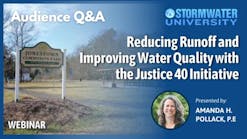A new substance found in residue from an experiment on refrigerants caught the attention of Dupont chemists nearly 100 years ago. They thought it had some interesting properties. It was resistant to water, grease, heat and decay. Soon it would be used to keep pots clean, to waterproof convertible car tops and to put out fires. Taking on such household names as Teflon and Scotchgard, and deployed for varied uses as firefighting, and the manufacture of extruded plastics, it would eventually be applied to the glamorous world of cosmetics, and, in such workaday products as grease resistant fast-food wrappers and microwave popcorn bags.
These chemicals don't exist in nature but can now be found, literally, everywhere and they do not break down in the environment, earning them the nickname “forever chemicals.” That amounts to a mess nearly a century in the making. Their technical name is Per- and polyfluoroalkyl substances (PFAS). Sophie Greene, Minnesota Pollution Control Agency's PFAS Coordinator said it is a large family of chemicals including 5,000 to 20,000 members.
Greene said that 3M, one of the major manufacturers that produces PFAS chemicals, had tested them in animal studies decades ago revealing their toxic effects. In December 2022, 3M announced it was cease production of PFAS by the end of 2025.
“Over a long time more evidence of toxicity has emerged,” she said.
Greene said the PFAS compounds PFOA (Perfluorooctanoic acid) and PFOS (Perfluorooctanesulfonic acid) are among the most toxic known. They can bind to protein and are not easily processed or excreted, giving them the potential to accumulate and do damage in the body over time.
“According to the EPA draft assessment PFOS and PFOA are two of the most toxic chemicals known for long-term exposure,” she said, with a carcinogenic potential greater than that of arsenic.
Hitting close to home
Marie LaPorte, a resident of Reisterstown, Maryland, a Baltimore suburb, lives several miles from a facility where she suspects firefighting foam containing PFAS had been used for training emergency personnel. She had been following reports of PFAS contamination at military bases and other facilities that used firefighting foams around the country and became concerned about her household's drinking water which is drawn from well water. Although her well is situated on formerly agricultural land, she decided to have it tested in March for the chemicals. The test revealed PFAS to be present at a concentration of 17 parts per trillion (ppt).
The exact source of the contamination, LaPorte said, “is unknown.” Contemplating the potential source, she said it could have originated in a fire-station or military facility in the area or it could have drained from a neighbor's septic system after running children's pajamas through the wash. Nonetheless, LaPorte was not entirely surprised.
“They're finding PFAS in polar bears and whales,” she said. According to the Environmental Working Group, the chemicals can be detected in the bodies of 99% of Americans as well.
The U.S. EPA has identified six PFAS compounds as warranting possible regulation for negative health effects, including risk of cancer and prenatal injury. In March, the Agency proposed maximum limits of 4ppt or 4ng/l of PFOA and PFOS in drinking water.
Greene said Minnesota began looking into PFAS contamination in 2002, when 3M alerted the state that they had detected PFAS in drinking water wells at their Cottage Grove production facility.
Tamping down on contaminants
With PFAS distributed so broadly, it would be a wonder if they were not also found in stormwater. Greene said; indeed, they have been.
She explains that “There has been a global contamination of our atmosphere with PFAS and that means there's a reservoir of these chemicals in the atmosphere, so when it rains there are very, very low trace concentrations of these chemicals in the rain.”
However, according to Brandon Steets, senior principal with Geosyntec Consultants, the bulk of PFAS in stormwater may be picked up either from the landscape, where PFAS may have been deposited through manufacturing or application such as firefighting foam or contaminated biosolids, or from materials and debris containing PFAS left out in the elements like food packaging and trash.
The sites contributing contaminated runoff include PFAS manufacturing facilities where previously allowable process air emissions distributed PFAS particulates far and wide, to settle on structures and grounds. These particles can be mobilized by rainfall. Additional hot spots include facilities that use PFAS where the contaminants may have escaped during other phases of handling and operations.
Fire-fighter training and military facilities and airport runways where Aqueous Firefighting Foam (AFFF) formulated with PFAS were used represent another branch of hotspots. Landfills containing discarded household goods, such as stain resistant carpets, or PFAS treated fabrics, can release PFAS from their surfaces to flow with runoff. And even fast-food wrappers littering the roadside, washed by rainfall can contribute to the contamination.
Steets said when thinking about risks of groundwater contamination from stormwater infiltration, there are four major considerations for any pollutant, these are; toxicity to humans, abundance in stormwater, mobility and persistence (TAMP).
“PFAS is a rare pollutant suite that checks all these boxes,” Steets said.
The presence of toxic, abundant, mobile and persistent contaminants can complicate decision making for stormwater managers. Steets said PFAS “is a perfect storm” as a challenging contaminant. He said unlike many contaminants found in stormwater, PFAS are not captured in the first few inches of topsoil, raising questions of potential risks to groundwater, at least until PFAS can be phased out of new products.
However, treatment technologies do exist that can remove PFAS effectively from stormwater, he said, but they are costly.
“We have a lot of passive stormwater filters where we incorporate a carbon source like activated carbon or biochar, but you'd need a lot of it, and it has to be done carefully,” Steets said. “And at certain industrial sites, we have active treatment systems (i.e., powered and using tanks) capable of removing over 99% of PFAS in stormwater. It's very expensive; you couldn't do that for an entire municipality with many stormwater discharge points.”
Blueprints for Action
The MPCA, nevertheless, has begun acting following through on its PFAS Blueprint. The Blueprint lays out a strategy based on a 3-tiered approach said Greene.
“The first tier is to prevent PFAS pollution, the second tier is to manage PFAS pollution in such a way that it's not causing human health concerns and the third tier is cleaning up,” Green said. “Unfortunately, in Minnesota we have a number of places where PFAS contamination has not been prevented, or managed appropriately, and we have an issue of human health concern, and we have to clean those sites up through our remediation program. Thats a very expensive and time-consuming process. So, we'd like to prevent more cleanup sites from being generated.”
Current activities under MPCA PFAS Blueprint include monitoring stormwater for PFAS at major airports that were required by law to use PFAS AFFF, along with monitoring at chrome finishing facilities where air emissions of process exhaust were known to have taken place. They have also started monitoring automobile shredding facilities where PFAS containing materials used in cars are possibly exposed to rain or snow melt as the vehicles are deconstructed.
“We are in the early stages of getting those results, and when do get the results, we'll be evaluating them and ensuring that any nearby drinking water receptors are protected,” said Justin Barrick, with the MPCA office of Water Quality Enforcement and Compliance.
While the MPCA's PFAS monitoring plan has prioritized potential hotspots, Barrick hints there may be a broader future for PFAS monitoring; “Our General Industrial Stormwater Permit is set to be reissued in 2025, and we're evaluating whether it's prudent to incorporate PFAS monitoring into that permit.”
Policy makers, and ultimately, public policy have a key role in meeting the challenge of PFAS. For example, Green said the Minnesota legislature has proposed a bill banning PFAS for non-essential uses in products. In Steets' view, the real solution, whether through legislation, regulation or persuasion, is to reduce PFAS at the source.
“For example, when you have less food packaging and outdoor products with PFAS you will presumably have less in stormwater,” he said.
Sitting with the unknown
LaPorte credits her GE refrigerator, with its built-in water filter, for providing a level of protection from PFAS in drinking water for her household. However, she concedes this is only by coincidence.
“I initially got the filter quite a while back because people were using a lot of pesticides,” she said. “I wasn't even thinking about PFAS at the time.”
While she worries for people who do not have the resources to test or filter their own drinking water, she also notes, that “reverse osmosis treatment works great but it doesn't help the wildlife.”
Greene said there are still a lot of questions to be answered about PFAS.
“We have a huge amount of information about a subset of these chemicals, but the unfortunate and scary thing is that there are thousands of chemicals in the family where we have almost no information at all,” Greene said. “Our concern is we may be starting to wrap our arms around the PFAS that we've been talking about today, but there might be 10 more PFAS that we might discover in ten years that are also toxic, and also pervasive, and we'll have to keep working on those.”
David Richardson writes on science and public policy and is a frequent contributor to Endeavor Business Media Publications. He is based in Baltimore, Maryland.






